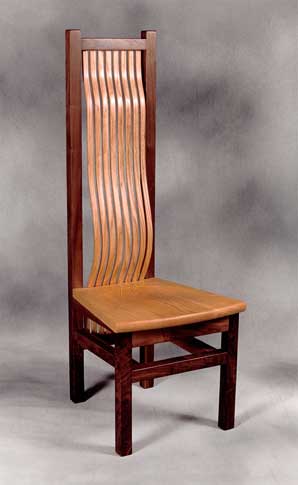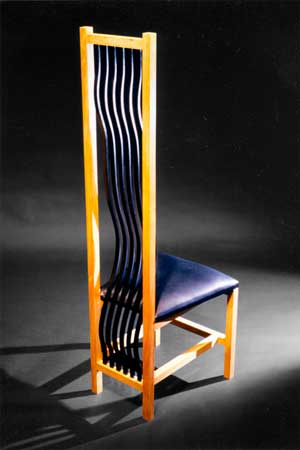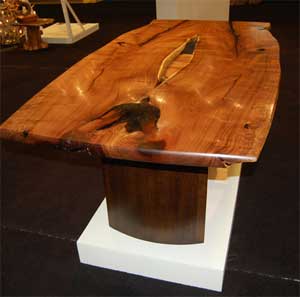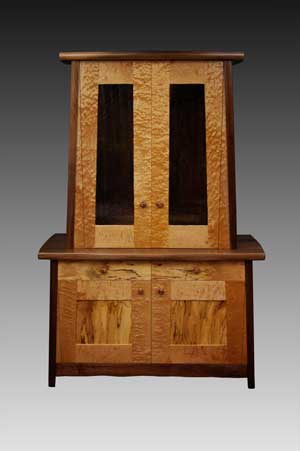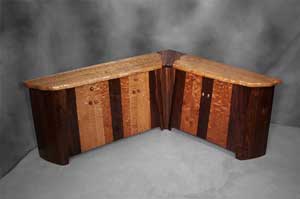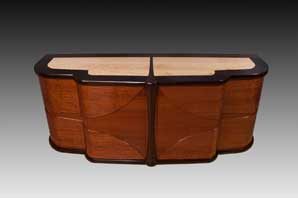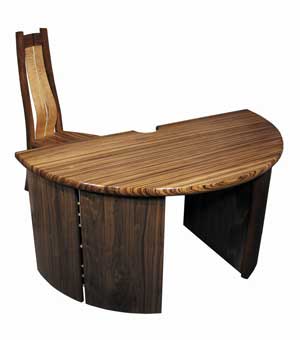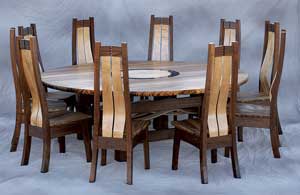
Earl Nesbitt has “always loved wood and furniture,” but he spent the first part of his career working as a machinist — until he decided to look for something more fulfilling. “I saved up all my money, got on my motorcycle and traveled around the country talking to all the schools” that taught woodworking, until he “found a guy doing exactly what I wanted to do.”
Earl served a year-long apprenticeship with furniture maker Jeffrey Greene in New Hope, Pennsylvania. While there, the first thing he designed and built on his own was a Wavy Back Chair: a linear frame with a wavy back. “It’s kind of a take-off on a Frank Lloyd Wright chair,” Earl said. “I took it to the next place by making it comfortable.”
He did that by adding curves and lumbar support to the back, and soliciting feedback on whether he’d achieved his comfort goals. “New Hope, Pennsylvania, is a tourist town. I’d done mockups after I’d sketched out my back and a number of the other apprentices’ backs and took them out onto the busy sidewalks, where I had a number of people of different sizes sit down and give me their feedback. I got almost no negative feedback, so I knew I was on the right track.”
These days, Earl still uses that method to seek feedback for projects, putting the mockups of chairs, especially, out for customers to try out at shows.
He has successfully made the transition from machinist to woodworker, combining what he calls a freeform sculptural aspect that has appealed to him with the meticulousness called for in furniture making that also fits his personality. “I also just love wood, its versatility, that you can make just about anything with it,” he said.
Earl describes his style of woodworking as contemporary, with clean lines. As he designs projects, he also likes to keep in mind a wide variety of woods. “I like to have ’em all at my availability,” he said. “As I’m designing, I’m keeping in mind, ‘This would look good in zebrawood,’ because it’s dramatic and striped, or ‘this would look better in a solid color.'”
Currently residing in New Mexico, Earl does note that there’s one wood he doubts would have been part of his repertoire if he’d remained in the East: mesquite. “It’s one of the most beautiful woods we have, and out here, we have access to some fairly big slabs. There are family businesses that go out and find the big boards. Mesquite is also extremely stable; it does not move very much with seasonal changes.”
One of his suppliers, Earl said, calls mesquite “rescued wood” because much of it comes from trees that are “in the middle of nowhere, past the decay stage, and we’re bringing it back to life.”
He’s also about to get into additional uses of other recycled materials, as many of his customers are expressing interest in getting LEED [Leadership in Energy and Environmental Design] points.
It was also a customer request that led to the piece that Earl says had “technical opportunities that took me to a whole new place in my career.” Previously, he had created a dining set — a large circular table and 10 chairs — for these clients, and last year, they decided that wanted a complementary corner cabinet/buffet and a china cabinet. Difficulties faced in these projects were the space requirements and meeting the asymmetrical, organic desired aesthetics.
The most difficult piece for the clients, however, was an entertainment center meant to complement their Art Deco style radio. It needed to be 8 feet long, and a “contemporary with an Art Deco look.” Earl used over 300 pieces of wood just in the four doors on the piece, which are created out of bubinga and Australian lacewood bent laminates. After milling the lumber to very thin, easily bent pieces, he had to do a lot of preliminary layout work to determine placement in the clamps for the glue-up — and then, “When it comes time for the glue-up, work fast!”
Earl’s been using bent laminations to some extent ever since that first Wavy Back Chair, but overall, he said, he enjoysteaching himself new techniques as part of his work. He does note, however, that he consistently likes to use construction techniques that are “beautiful as well as functional.” For instance, he built a semicircular desk, the base of which has sliding pegs. “They’re a definite part of the piece, but they’re also functional: the pegs allow for seasonal wood movement,” he said.
And, he noted again, he loves the sculptural aspect of his work. “I enjoy when I get the grinder in my hand: sculpting an edge or an interesting shape is something I truly enjoy about the work.”
